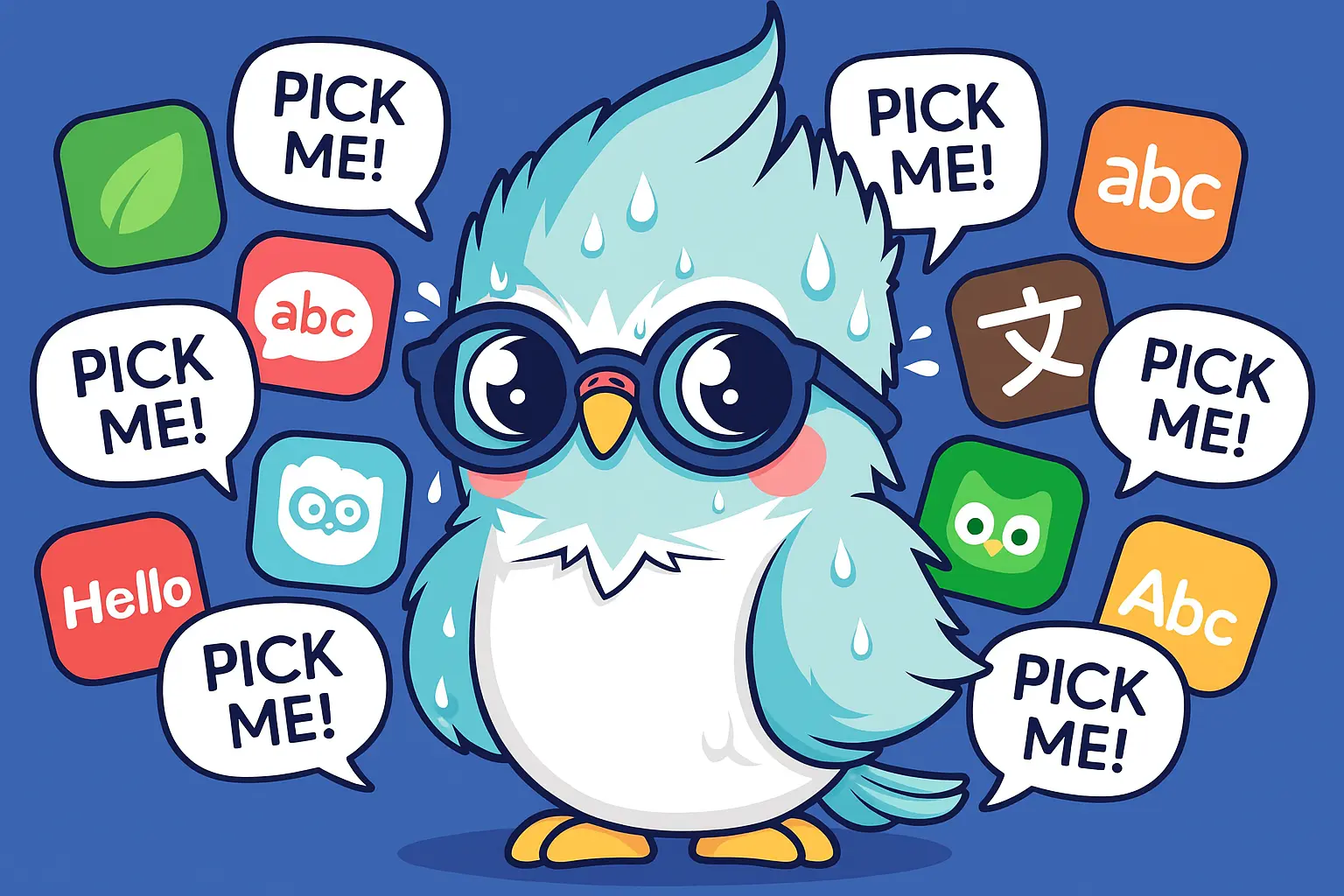Comparison of The Best AI Language Learning Apps
| App Name | Price / Year | Languages | Primary Focus | App Store (US) | Pros (Reviews) | Cons (Reviews) |
|---|---|---|---|---|---|---|
Free (10 min/day) Premium $80 | 10 | Speaking Practice, Pronunciation | iOS: 4.8⭐ Android: n/a | 🐦 Friendly AI character ⚡ Instant corrections 💪 Builds confidence | 📵 No Android version ❌ No grammar lessons | |
$84 (for Speaking & Listening) | 7 | Comprehensive | iOS: 4.8⭐ Android: 4.7⭐ | 🎯 Fun & engaging | 💸 Expensive Max tier 🌍 AI roleplay limited languages 🔁 Drill-based | |
Free trial Premium $100 | 1 | Spoken English with 3D avatars | iOS: 4.8⭐ Android: 4.8⭐ | ✨ Immersive chats 💪 Motivating ⚡ Instant feedback | 🇬🇧 English-only 🔧 Some AI quirks 📶 High bandwidth needed | |
Free trial Premium Plus $235 | 3 | Conversational English | iOS: 4.8⭐ Android: 4.8⭐ | 🗣️ Natural AI conversation 📚 Many practice scenarios | 💰 Pricey 🌐 Limited languages 🤓 Advanced users want deeper discussions | |
Free trial Premium $160 | 1 | English Pronunciation | iOS: 4.8⭐ Android: 4.7⭐ | 🎯 Precise phoneme feedback 📚 Huge library ✅ Proven results | 🇺🇸 American accent only 😵 Overwhelming 🎤 Recognition imperfect | |
Free trial Premium $150 | 1 | Spoken English Practice | iOS: 4.9⭐ Android: 4.9⭐ | 👩🏫 Real tutor feel ⚡ Immediate feedback 💪 Motivating | 🇬🇧 English-only 🆓 Limited free version 🔧 Minor AI quirks | |
Free trial Pro $82 | 20 | Vocabulary + Conversation | iOS: 4.8⭐ Android: 4.5⭐ | 🧱 Great vocab building 📚 Large library 💬 Conversational practice | ⌨️ Text-based conversation 📉 Variable course quality 🗣️ Not strong on speaking | |
Free basic Premium $90 | 50 | Conversation | iOS: 4.7⭐ Android: 4.0⭐ | 🌍 Many languages ⏱️ Real-time corrections | 🤖 Robotic AI voice ❌ Sometimes inaccurate 🆓 Very limited free plan |
Do AI Language Learning Apps Work?
Over the past few years, language-learning apps have evolved dramatically from simple flashcard systems into sophisticated, AI-driven platforms. This transformation has revolutionized how we approach language acquisition, enabling learners to converse with voice-based tutors, receive instant feedback on pronunciation, and engage in realistic role-playing scenarios - all through their smartphones.
While these AI-powered tools offer unprecedented opportunities for language practice, no single app can guarantee fluency on its own. The effectiveness varies significantly across platforms: some excel at building vocabulary, others specialize in conversation practice, and certain apps focus primarily on perfecting pronunciation. These applications serve as powerful supplementary tools when combined with additional learning methods, such as consuming native content, reading articles in your target language, or participating in live language exchange sessions.
Navigating the increasingly crowded landscape of AI language learning apps can feel overwhelming. To help you make an informed decision based on your specific learning needs and goals, we’ve compiled a comprehensive comparison of the most effective AI-powered language learning options available in 2025.
Why ChatGPT Isn’t the Best Language Tutor
ChatGPT has undoubtedly transformed many aspects of digital learning, including language acquisition. With its voice mode capabilities in certain integrations, it might seem like an obvious choice for language practice. However, despite its impressive versatility, ChatGPT wasn’t designed specifically as a language learning platform.
While it can generate examples, correct grammatical errors, and engage in conversational exchanges across multiple languages, maximizing its potential requires expert prompting skills to create focused, structured practice sessions. ChatGPT lacks many specialized features that purpose-built language learning apps provide as standard offerings:
- Structured curriculum progression
- Gamified achievement systems that maintain motivation
- Built-in pronunciation assessment tools
- Spaced repetition algorithms for optimal vocabulary retention
- Language-specific scenario role-plays tailored to common real-world situations
- Comprehensive progress tracking and analytics
ChatGPT serves as an excellent supplementary resource for answering specific language questions or for impromptu conversations, but it cannot replace dedicated AI language learning applications engineered specifically to develop and reinforce language skills systematically over time.
Top AI Language Learning Apps in 2025
1. Kippy AI
Kippy AI offers a refreshing approach to language practice through friendly, low-pressure daily conversation sessions and speaking practice in real-life scenarios . The app features a cheerful “budgie” avatar that interacts naturally with users, providing gentle corrections to spoken communication, both in grammar and context . Kippy aims to replicate casual, everyday conversations while offering immediate feedback in a supportive environment.
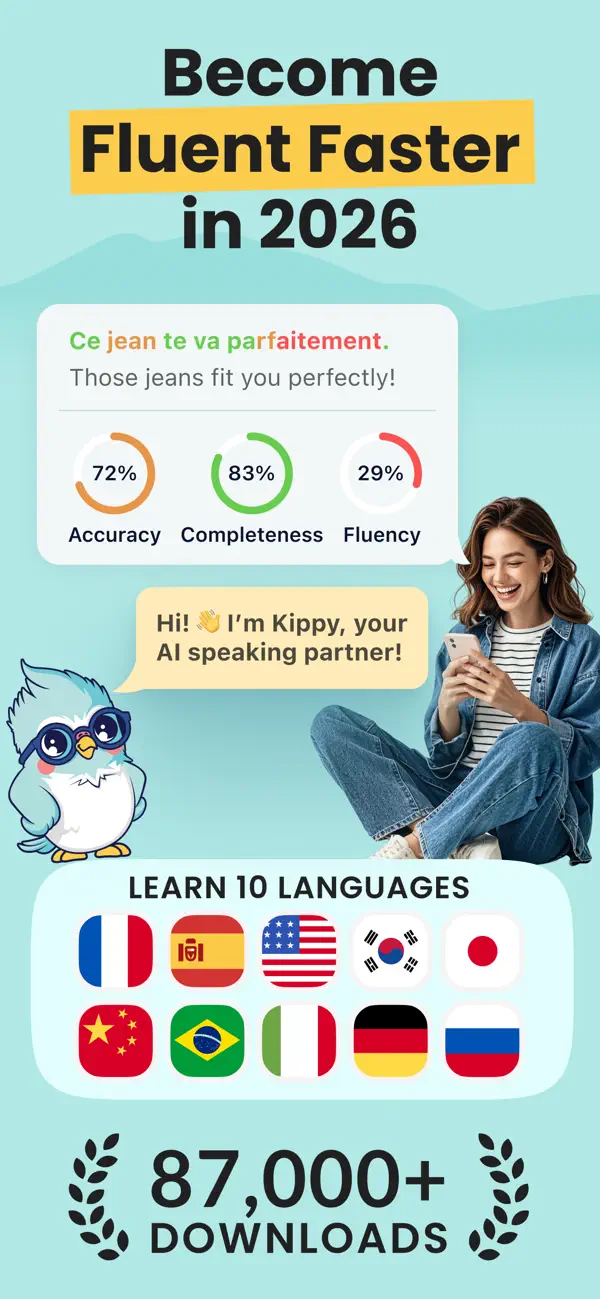
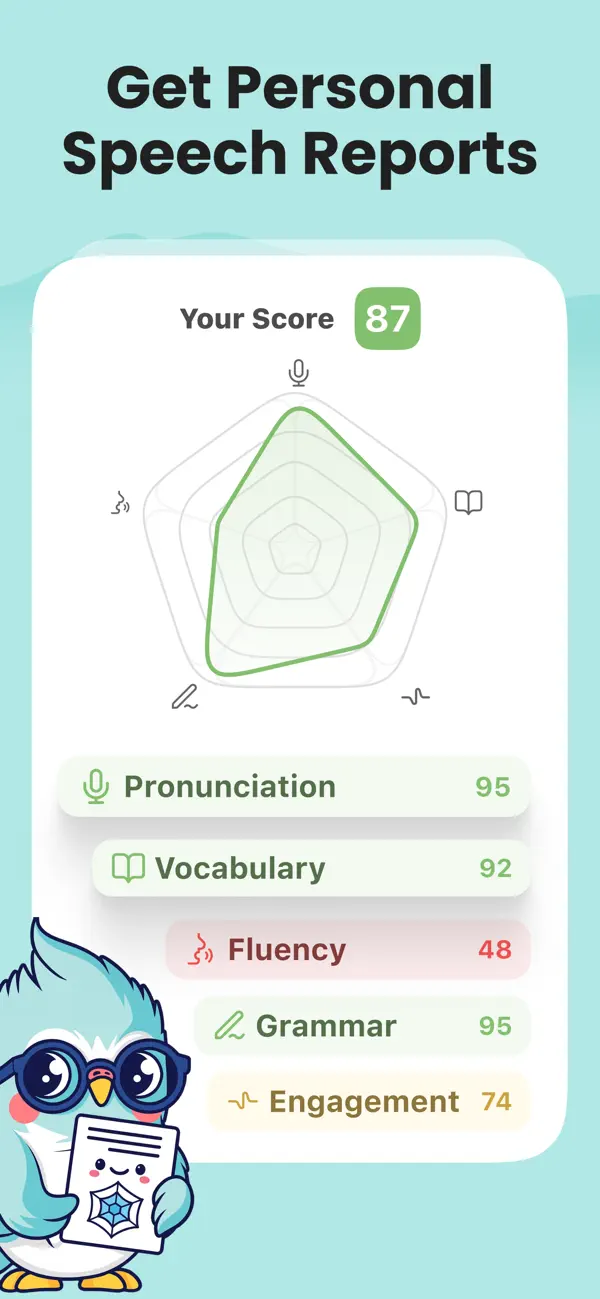
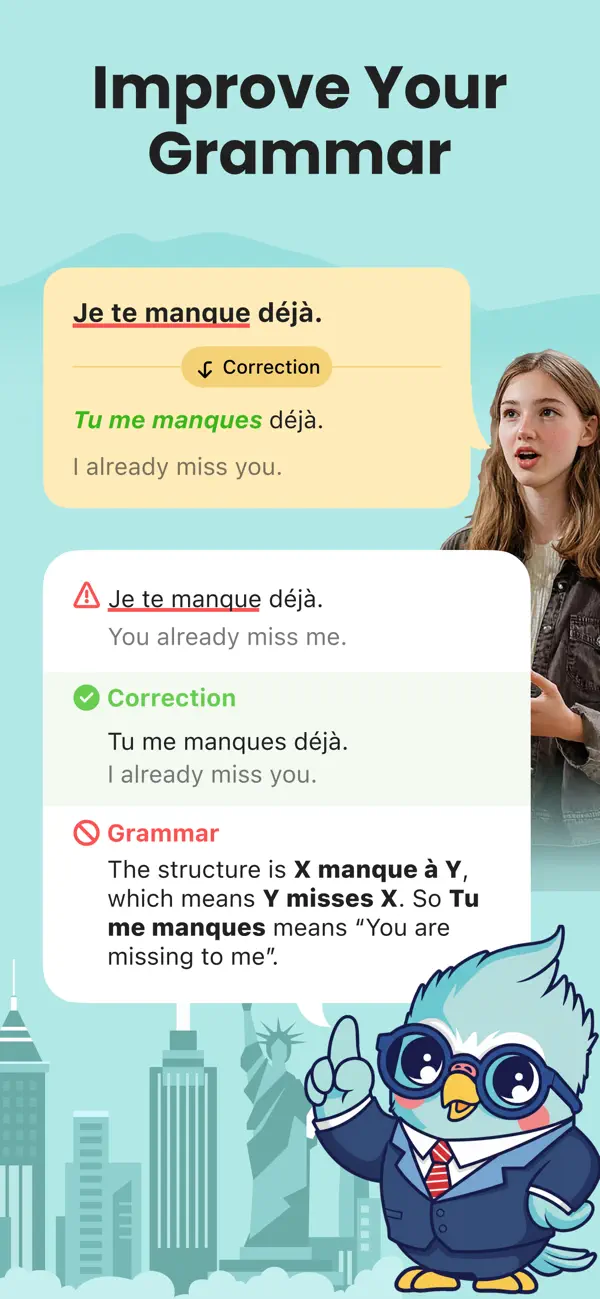
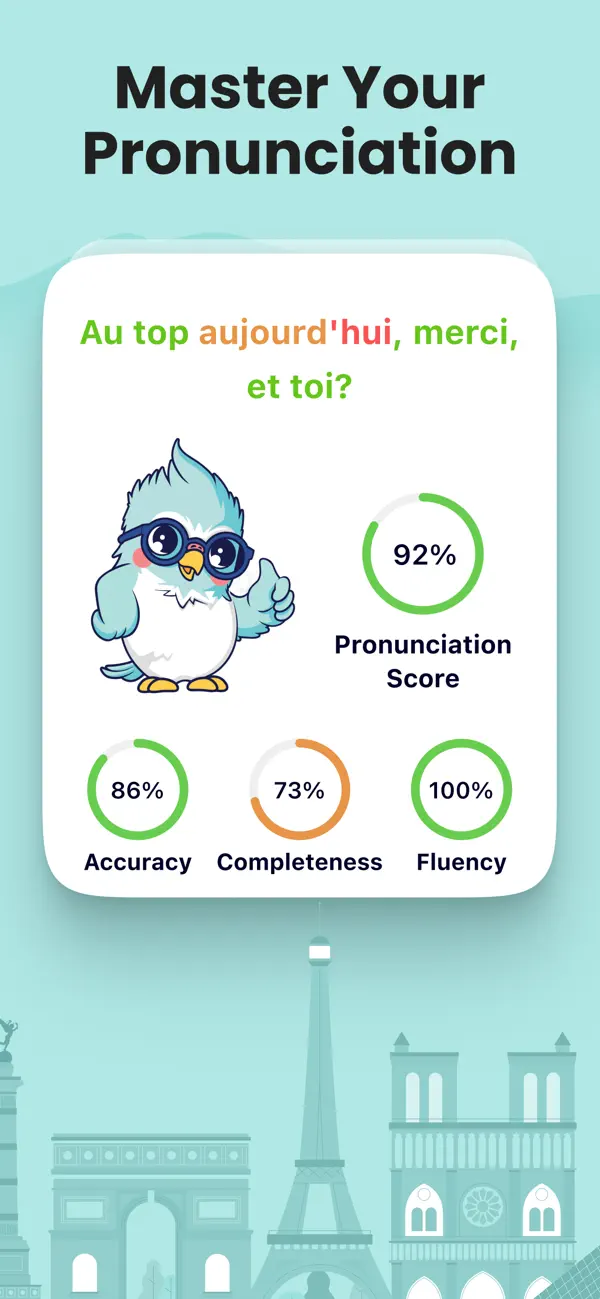
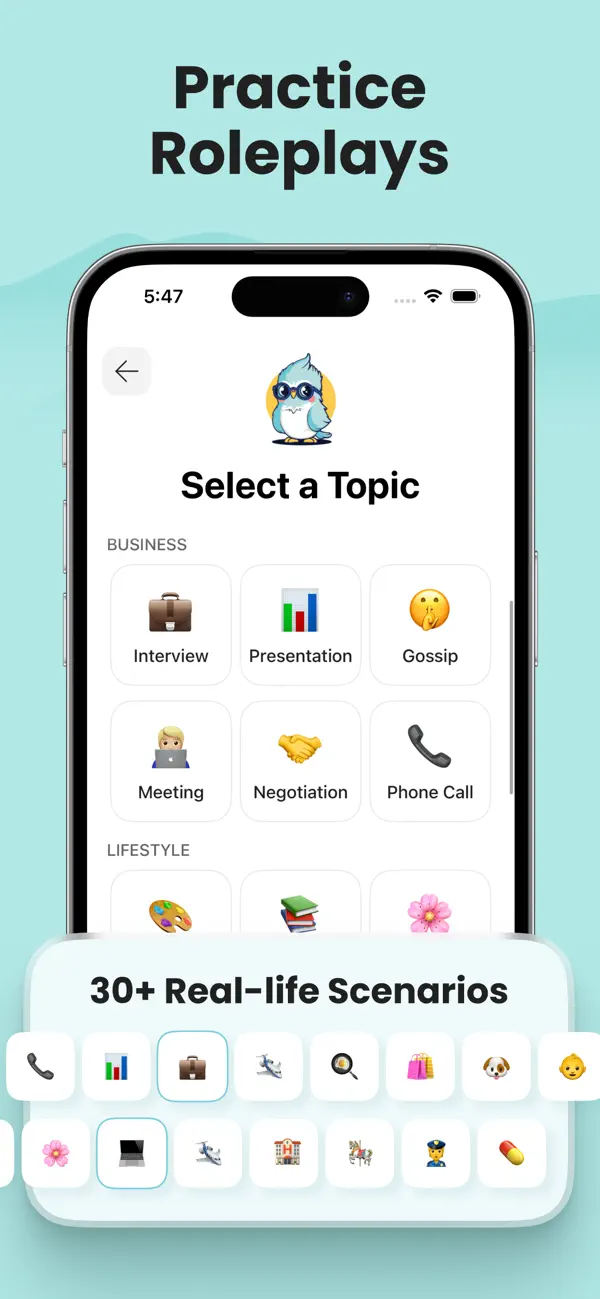
Download Kippy AI
📱 iPhone/iPad
(Android version coming soon)
How It Works
- Choose from 10 supported languages including English, Spanish, French, German, Korean, and others
- Simply tap the microphone button to begin conversing with Kippy
- Receive contextual responses with highlighted corrections and improvement suggestions
- Track your progress through the app’s analytics and vocabulary reports to see your learning progress over time
Pricing
Free tier: 10 minutes of conversation every day for free, forever.
Premium: $79.99/year unlocks unlimited conversation practice and comprehensive correction tools.
Pros
- Intuitive, user-friendly interface with a gentle learning curve
- Comprehensive multi-language support within a single platform
- Real-time corrections include suggested translations and alternative phrasing options
- Adaptive AI remembers your common mistakes and tailors future conversations accordingly
Cons
- Advanced learners sometimes find the AI’s conversational depth somewhat limited or repetitive
- Beginners find the conversation to be difficult to follow
- As a relatively new platform, it has a smaller community for support and user-generated content
As a newer platform, Kippy AI shows promise but may need time to develop a more comprehensive feature set.
2. Duolingo Max
Duolingo has maintained its position as one of the most popular language learning platforms, largely due to its highly engaging, gamified approach. The platform guides learners through a structured “tree” of lessons, each designed to teach vocabulary and grammar through brief, entertaining exercises. The premium “Max” subscription, powered by OpenAI’s GPT-4 technology, introduces advanced features such as AI Roleplay — where users can participate in simulated conversations with Duolingo’s characters — and Explain My Answer, which provides personalized grammar explanations tailored to your specific mistakes.
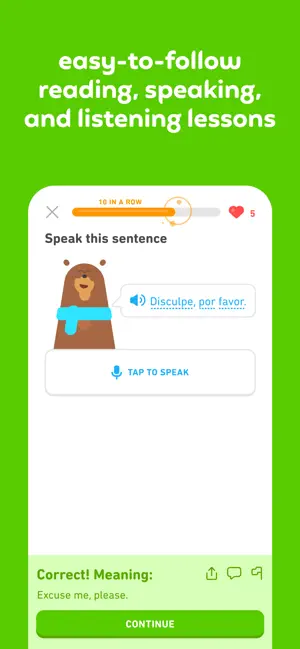
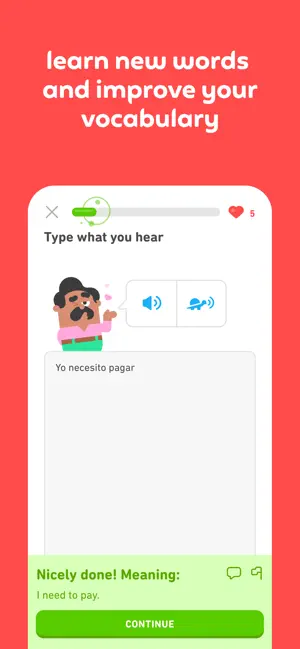
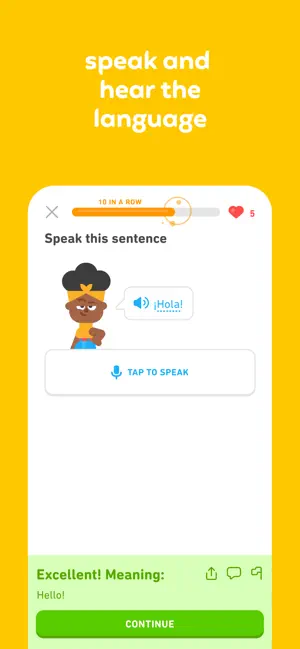
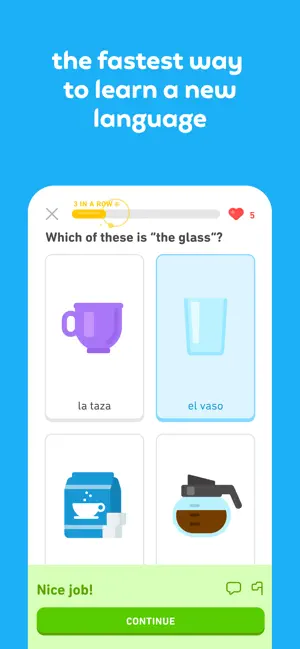
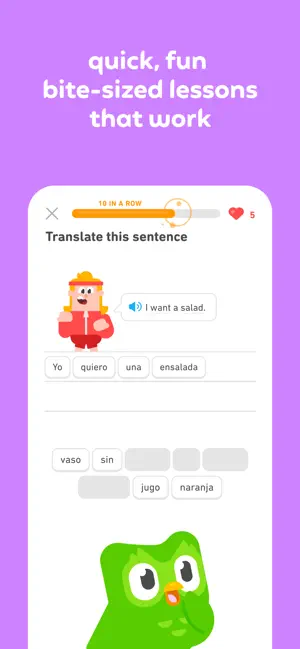
Download Duolingo
📱 iPhone/iPad • 🤖 Android
How It Works
- Select from over 40 target languages (including Spanish, French, Japanese, and more)
- Complete bite-sized lessons ranging from 2–5 minutes each
- Max subscribers can engage in AI Roleplay scenarios to practice contextual dialogues with feedback on errors
- Maintain motivation through the app’s streak system and game-like rewards
Pricing
Free plan: Includes ads, limited hearts (attempts before penalties), and fewer advanced exercises
Super Duolingo: Approximately $84/year offering unlimited mistakes, ad-free experience, and additional features
Pros
- Highly entertaining and addictive structure encourages daily practice
- Extensive language library with approximately 40 languages for learners at all proficiency levels
- AI roleplays provide engaging, interactive reinforcement of lesson content
- Cross-platform synchronization allows seamless learning across devices
Cons
- Max tier pricing is higher than competing apps with similar features
- Limited AI roleplays currently available, reducing the value proposition for the premium price
- Many users report that Duolingo’s drill-based approach isn’t sufficient for developing natural conversation skills
- AI Roleplay feature is currently limited to select major languages (Spanish, French, English)
These features make Duolingo Max a compelling choice for learners seeking a gamified approach to language learning.
3. Praktika
Praktika distinguishes itself through its immersive 3D avatar system that simulates face-to-face interactions. Currently focused primarily on English language learners, the app offers diverse scenarios — ranging from ordering coffee and navigating job interviews to engaging in everyday small talk. The lifelike AI personas speak naturally, listen to your responses, and provide real-time feedback on grammar, vocabulary, and pronunciation accuracy.
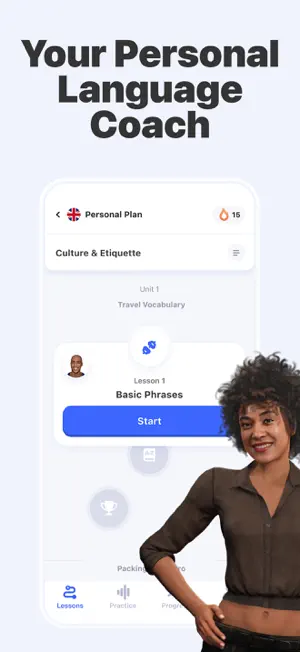
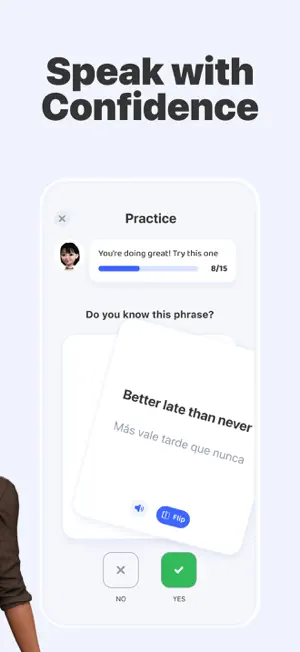
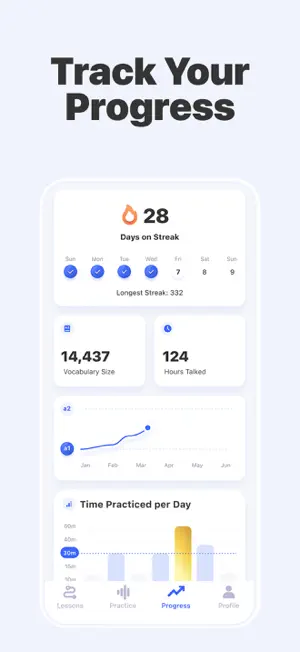
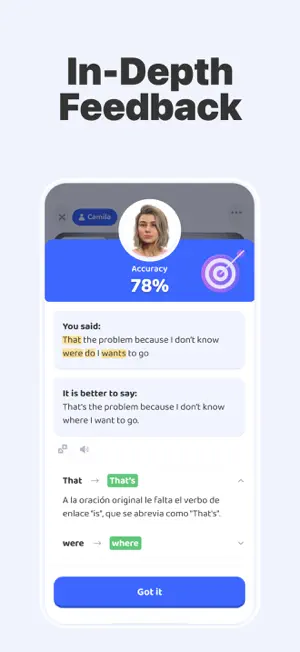

Download Praktika
📱 iPhone/iPad • 🤖 Android
How It Works
- Select from practical scenarios (e.g., “Travel: Airport Check-In”, “Business: Negotiation Basics”)
- Interact with responsive 3D avatars with realistic lip‑sync for added immersion
- Speak naturally while the AI provides contextual feedback and suggestions
- Get detailed grammar and pronunciation guidance with the option to repeat challenging parts
Pricing
Free trial available for new users to explore basic features
Premium: $99.99/year for unlimited practice across all scenarios
Pros
- Realistic avatar interaction reduces speaking anxiety common in language learners
- Engaging, scenario-based lessons provide practical, real‑world language skills
- Immediate correction system enables iterative improvement during each session
- High‑quality voice recognition accurately identifies subtle pronunciation errors
Cons
- Currently limited to English language learning
- Requires stable internet connection and can be resource‑intensive due to the video interface
- Occasional AI response inconsistencies or correction inaccuracies may occur
Despite some technical limitations, Praktika’s innovative immersive approach sets it apart in the market.
4. Speak
Speak focuses on delivering natural-sounding, AI-driven dialogue primarily designed for English language learners. The application’s sophisticated voice-based AI tutor creates an experience remarkably similar to conversing with a real language partner — asking follow-up questions, exploring topics naturally, and providing detailed corrections for grammar, usage, and pronunciation errors.
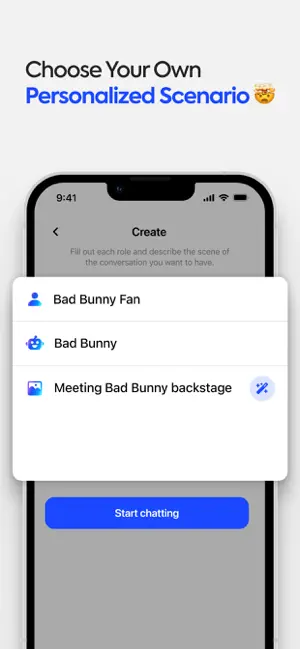
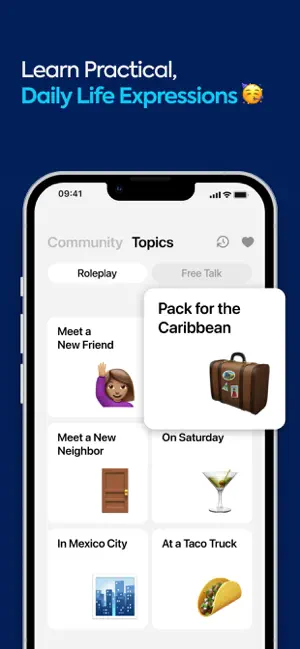
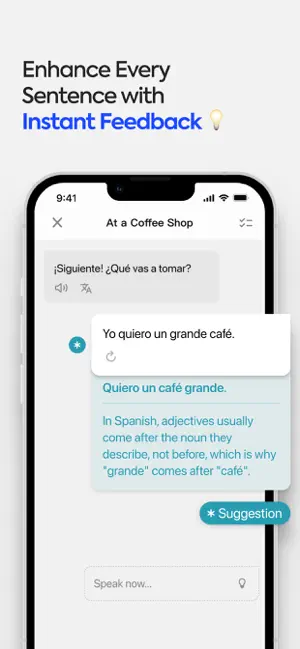

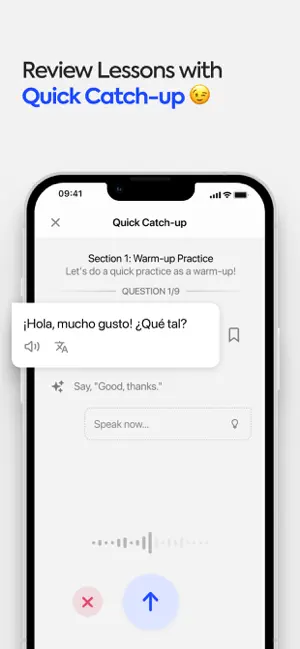
Download Speak
📱 iPhone/iPad • 🤖 Android
How It Works
- Engage in verbal conversation with the app’s remarkably human-like voice interface
- View real-time corrections highlighting mistakes alongside suggested improvements
- Choose between structured lesson plans or free-form conversation based on your preferences
- Receive detailed pronunciation guidance with visualizations of correct mouth positions
Pricing
Free trial available to test core features
Premium: $234.99/year for unlimited access
Pros
- Exceptionally natural-sounding AI voices
- Comprehensive feedback system that explains the reasoning behind corrections
- Particularly effective at building speaking confidence for real-world language use
- Adaptive conversation topics that adjust to your proficiency level and interests
Cons
- Higher subscription cost compared to several alternatives with similar functionality
- Primary focus on English language learning, though additional languages are reportedly in development
- Some advanced speakers desire more specialized or technical conversation topics
While primarily focused on English, Speak’s natural conversation capabilities make it a strong contender in the AI language learning space.
5. ELSA Speak
ELSA Speak (English Language Speech Assistant) has established itself as the premier solution for American English pronunciation refinement. Utilizing advanced speech recognition technology, ELSA identifies specific phonemes you mispronounce and provides detailed coaching on proper mouth and tongue positioning. The platform offers thousands of carefully crafted exercises spanning individual words to extended dialogues.
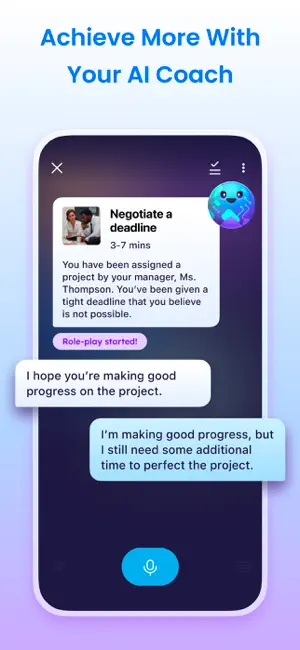
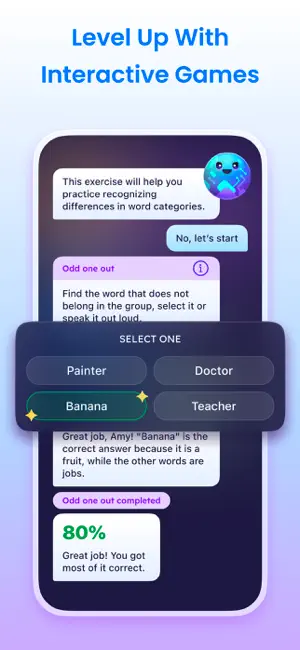

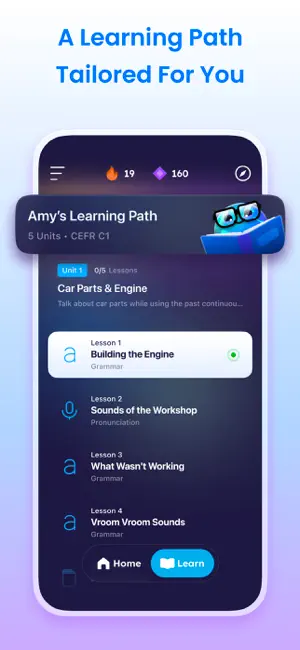
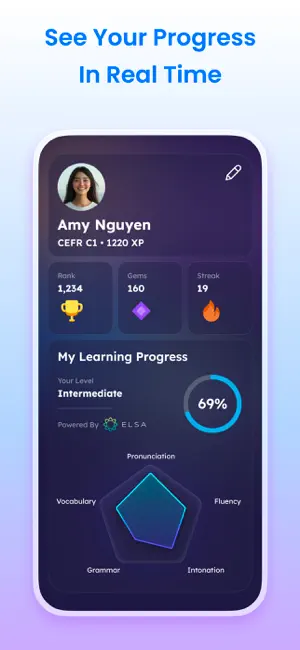
Download ELSA Speak
📱 iPhone/iPad • 🤖 Android
How It Works
- Record specified words or sentences for AI analysis at the phoneme level
- Receive color‑coded visual feedback (green for correct pronunciation, red/orange for areas needing improvement)
- Follow personalized lesson paths that adapt to your specific pronunciation challenges
- Access visual guides demonstrating correct tongue and lip positions for difficult sounds
Pricing
Freemium model with limited daily usage
Pro: Approximately $159.99/year
Pros
- Offers some of the most precise and detailed pronunciation feedback available
- Extensive lesson library covering practical phrases, tongue‑twisters, and contextual dialogues
- Proven track record helping non‑native speakers improve intelligibility
- Specialized modules for professionals in fields like healthcare, education, and business
Cons
- Focuses exclusively on American English accent training
- Can feel technically demanding for beginners due to the detailed phonetic approach
- Speech recognition accuracy may decrease in noisy environments
- Limited value for those primarily seeking grammar or vocabulary development
ELSA’s specialized focus on pronunciation makes it an invaluable tool for those seeking to perfect their English accent.
6. Loora
Loora specializes in English conversation practice through daily, guided speaking sessions. The platform aims to recreate the experience of working with a personal language tutor, as its sophisticated AI provides immediate corrections on pronunciation, grammar, and word choice while maintaining natural conversational flow.
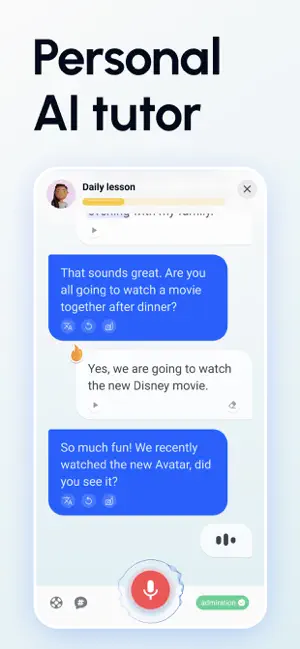
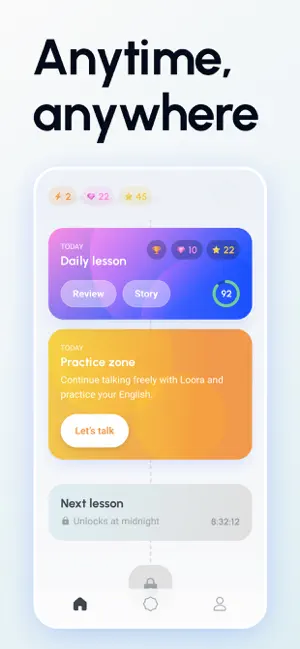
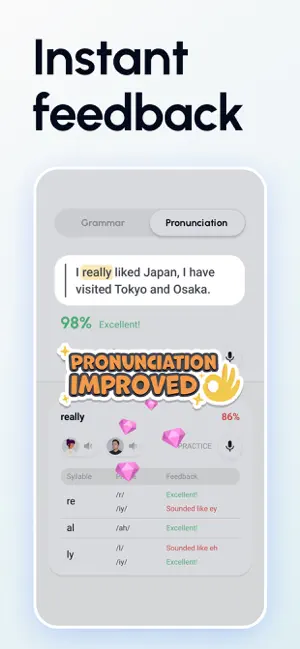
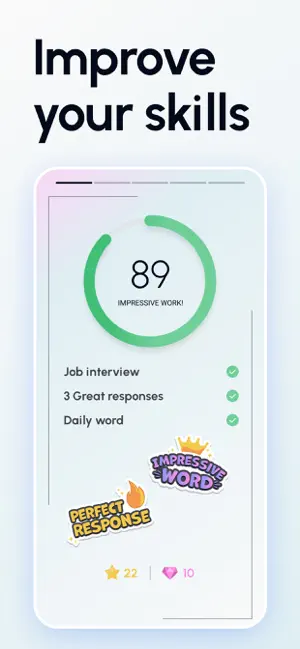
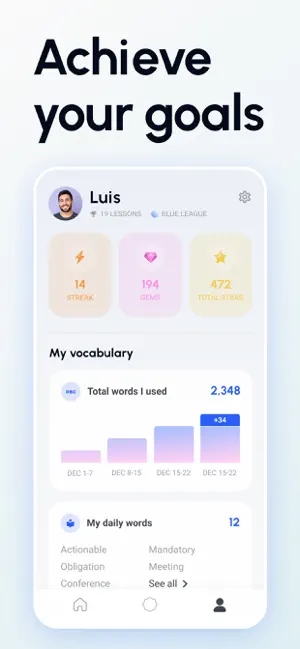
Download Loora
📱 iPhone/iPad • 🤖 Android
How It Works
- Choose from curated lesson topics or engage in unrestricted chat sessions
- Receive non‑disruptive intervention with corrections or suggestions as you speak
- Build consistency through the app’s streak tracking and achievement system
- Access detailed performance analytics highlighting areas of improvement
Pricing
Free trial with restricted usage limits
Premium: $149.99/year for full access
Pros
- Conversational interface strikes an encouraging, supportive tone that reduces speaking anxiety
- Real‑time feedback addresses both major errors and subtle pronunciation nuances
- Highly regarded for effectiveness in establishing consistent daily speaking habits
- Specialized vocabulary modules for different professional contexts
Cons
- Currently limited to English language learning
- Extremely restricted free plan essentially functions as a brief demo
- Occasional recognition difficulties with very rapid speech or heavy slang
- Some users report wanting more advanced grammatical explanations
Loora’s personalized approach to English conversation practice makes it a valuable tool for dedicated language learners.
7. Memrise + MemBot
Memrise has established itself as a leader in vocabulary acquisition through its effective flashcard system and authentic video clips featuring native speakers. The recent introduction of MemBot, an AI chatbot companion, enhances the platform by allowing users to practice textual conversations in their target language — seamlessly integrating newly learned vocabulary into natural sentence structures.
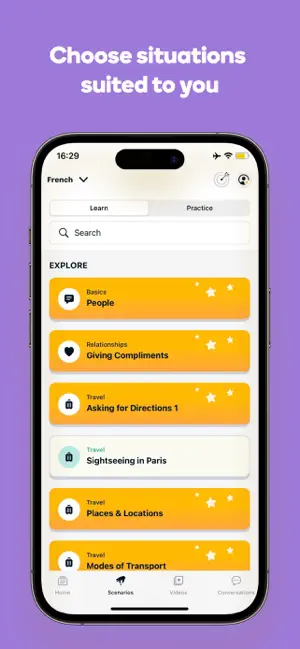
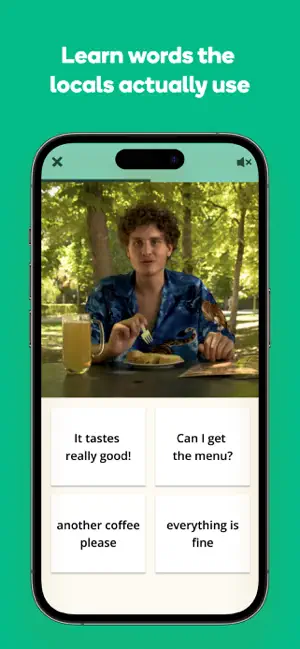
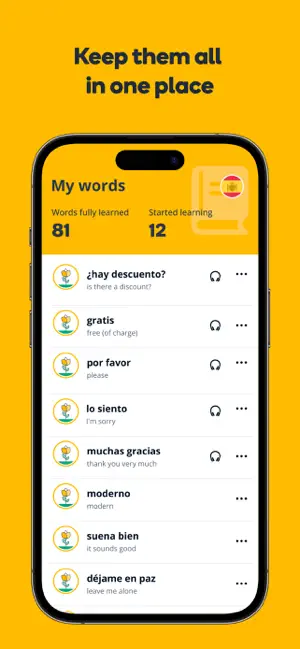
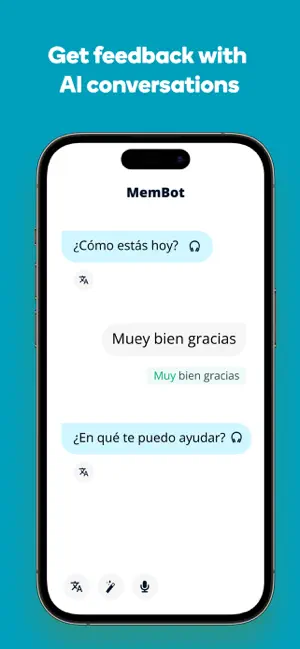
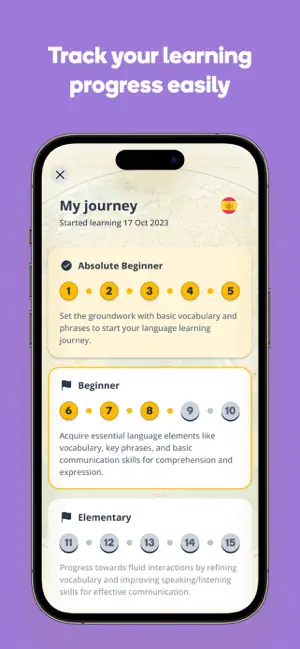
Download Memrise
📱 iPhone/iPad • 🤖 Android
How It Works
- Select from official Memrise courses or community-created content to build vocabulary through spaced repetition
- Practice textual conversations with MemBot, receiving instant feedback and improvement suggestions
- Enhance listening comprehension through the “Learn with Locals” feature with native speaker videos
- Customize learning paths based on your goals and interests
Pricing
Freemium model with substantial content available without subscription
Pro: Approximately $81.99/year
Pros
- Exceptionally effective for rapid vocabulary building across many languages
- Flexible learning structure allows focus on personally relevant content
- MemBot integration adds conversational practice to reinforce vocabulary
- Extensive offline functionality for learning without internet access
Cons
- AI chat is text-based without voice interaction options
- Quality inconsistency in user-created courses requires careful selection
- Less comprehensive for advanced speaking or grammar skills compared to conversation-focused apps
- Primary strength remains vocabulary rather than holistic language acquisition
Memrise’s combination of traditional vocabulary learning with AI chat features provides a well-rounded learning experience.
8. TalkPal
TalkPal offers impressive language diversity with support for over 50 languages, facilitating both voice and text-based conversations. The platform centers around practical role‑play scenarios — such as restaurant ordering, travel planning, and healthcare interactions — designed to build functional communication skills. Users receive basic correction feedback on grammar, vocabulary, and pronunciation in real-time.
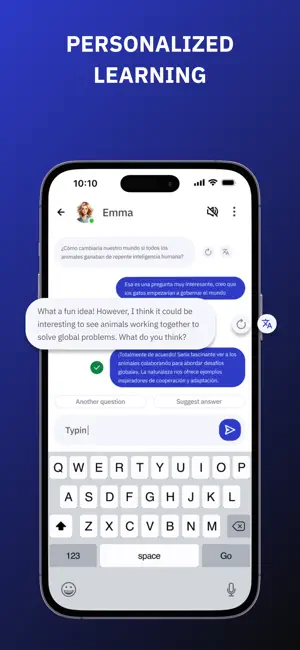
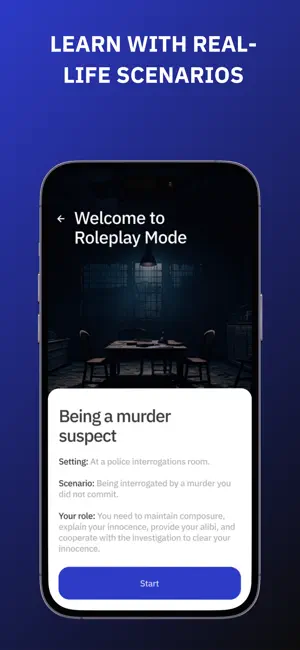
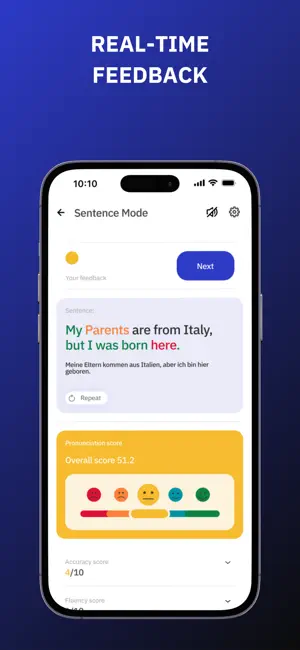

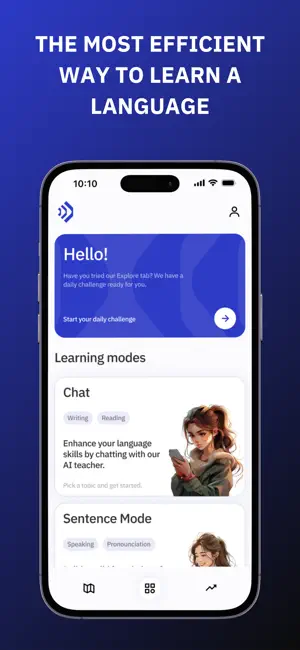
Download TalkPal
📱 iPhone/iPad • 🤖 Android
How It Works
- Choose from a wide selection of conversation scenarios or engage in open‑ended chat
- Receive on‑demand translations when encountering unfamiliar words or phrases
- Practice with daily topic prompts designed to expand vocabulary across contexts
- Track improvement through the app’s progress monitoring system
Pricing
Free plan: Limited to 10 minutes of daily AI conversation
Premium: $89.99/year for unlimited usage across all languages
Pros
- Unmatched language selection including less commonly taught languages and regional dialects
- Diverse role‑play scenarios provide engaging, practical conversation practice
- Real‑time feedback helps identify and correct recurring mistakes
- Seamless switching between multiple languages under one subscription
Cons
- Voice synthesis quality varies significantly across languages
- Inconsistent correction accuracy or repetitive conversation patterns reported by some users
- Heavily restricted free version limits meaningful evaluation before purchase
- Limited grammar explanation depth compared to education‑focused alternatives
Choosing the Right AI Language Learning App
When selecting an AI language learning app, consider these key factors:
- Learning Goals: Identify whether you’re primarily focused on conversation skills, pronunciation refinement, vocabulary building, or comprehensive language acquisition.
- Target Language: Not all apps support all languages equally. Check whether your desired language has full feature support before committing.
- Learning Style: Consider whether you prefer gamified experiences, structured lessons, free‑form conversation practice, or role‑play scenarios.
- Budget Considerations: While free tiers provide valuable starting points, premium features often deliver the most substantial learning benefits.
- Time Commitment: Some apps excel with brief daily sessions (like Duolingo), while others are designed for longer, more immersive practice (like Praktika or Speak).
The most effective approach often involves combining multiple resources. For example, using Duolingo for structured grammar practice, supplementing with Speak for conversation skills, and reinforcing vocabulary through Memrise can create a well‑rounded language learning ecosystem.
The Future of AI Language Learning
As AI technology continues to advance, we can expect increasingly sophisticated language learning applications that further blur the line between artificial tutors and human instructors. Developments in emotional intelligence, cultural context understanding, and hyper‑personalized learning paths promise to make AI language learning even more effective in the coming years.
The most successful language learners will be those who leverage these powerful AI tools while also seeking authentic communication opportunities with native speakers. By combining technological advantages with human connection, the path to language fluency becomes more accessible than ever before.
Frequently Asked Questions
Can AI tutors teach any language effectively?
It depends on the language and the app. Most AI language learning apps use similar language models trained on publicly available content, so languages with more online content generally produce better results. For example, Kippy supports only 10 major languages because they maintain quality standards with native speaker verification, while other languages didn’t meet their quality criteria yet. Popular languages like English, Spanish, and French typically have the most robust AI support.
Do AI language learning apps replace traditional study methods?
Not completely, at least not yet. AI tutors and language apps work best as companions to your regular study routine rather than complete replacements. Their main strength is accelerating your path to fluency by providing unlimited practice opportunities, instant feedback, and personalized corrections. You’ll still benefit from consuming native content, reading in your target language, and having conversations with real people.
How much does it cost to use AI language learning apps?
Pricing varies widely, but many apps offer meaningful free access. Kippy stands out by providing 10 minutes of conversation practice daily, forever, for consistent daily practice. For premium features, mid-range options like Kippy ($79.99/year) offer excellent value compared to more expensive alternatives like Speak ($234.99/year). Limited free tiers from Duolingo and TalkPal are also available, though most meaningful practice requires a subscription.
Are AI language tutors effective for building real conversation skills?
Yes, but effectiveness varies by app and your learning approach. Apps like Kippy and Praktika excel at natural conversation practice, while others like ELSA focus specifically on English pronunciation. The key advantage is that AI tutors provide unlimited, judgment-free practice opportunities with instant feedback. However, they work best when combined with real human interaction to develop cultural context and natural speech patterns.
Which AI language learning app should I choose as a beginner?
For complete beginners, start with apps that offer structured progression like Duolingo Max for its gamified approach and clear learning path, or Kippy for gentle, supportive conversation practice. It’s best to start when you have basic vocabulary. Consider your learning style: choose gamified apps if you need motivation, or conversation-focused apps if you learn better through speaking practice.
